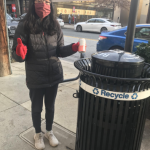Microplastics: From Our Products to Our Plates
By Sander Schulman, Environmental Leader
Plastics are everywhere. Their durable and light structure makes them useful in a multitude of ways. From synthetic fibers to packaging to wire insulation, we are surrounded by plastic on a daily basis. As useful as these plastics are, their durability makes them difficult to break down after they’ve become obsolete. The long lasting waste that results can cause extensive damage to our environment and the animals living there. What’s even worse is that the longer macro-plastics float around in rivers and lakes, the more likely these single-use pollutants will break down into much smaller, almost untraceable pieces called microplastics. They can be categorized as any fragment of plastic “less than 5 mm in length,”(1). While these may sound less harmful than larger, more intact plastics, the impact is equally as devastating. Microplastics are more easily ingested by marine animals, which can travel up the food chain, resulting in trophic level plastic accumulation in humans (2). Many types of microplastics can contain hazardous toxins such as “bisphenol A (BPA), a chemical that is used to harden plastics such as water bottles and food containers. The chemical has caused concern over the effects it has on the brain and possible effects on fetuses and their development,”(2). As microplastics become more prevalent in bodies of water around the world, the local Potomac and Chesapeake Bay area aren’t left unscathed.
A 2017 study in the Potomac River around Washington, DC, found microplastics accumulating in underwater grasses. In 2014, they were found in 59 of 60 water samples taken from the Patapsco, Magothy, Rhode and Corsica rivers (4). These results shouldn’t come as a surprise. As littered macro-plastic waste floats for weeks down rivers such as the Potomac, UV light slowly breaks it apart in the water, easily getting pieces caught up by grasses and soil. However, littering in rivers isn’t the only way microplastics are making their way into the Chesapeake Bay. A lot of plastic waste has also been found to pass through sewage treatment plants, which aren’t designed to locate and remove microplastics. According to the state-federal Chesapeake Bay Program, there are 516 major sewage plants in the Bay region, and a study found that each releases an average of 4 million microplastics a day (4). Microplastics are also being whisked up in the air, where they can travel long distances before falling back to the ground or getting washed out by rain. In a recent study, researchers sampled the air at 11 protected areas in the United States over a 14 month period and found an amount of microplastics equivalent to 120 million plastic water bottles (4). While these aren’t results specific to the Chesapeake, they show a clear and staggering trend of air contamination all across the country, the Chesapeake Bay area included.
The real danger happens when marine animals mistake these plastics for food sources and consume them. Ingested microplastics can cause physical damage to organs and excrete hazardous chemicals—from the hormone-disrupting bisphenol A (BPA) to pesticides—that can compromise immune function and stymie growth and reproduction (6). These unlucky animals who ate alarming amounts of microplastics are then caught, killed, and prepared for human consumption. Since microplastics can be so small, most people are completely unaware that they could be intaking significant amounts of plastic with every meal. It is projected that the average person eats at least 50,000 particles of microplastic a year and breathes in a similar quantity (7). While the effects of long term microplastic consumption haven’t been fully determined, it’s clear that if we don’t find ways to keep our plastic waste out of the water there could be detrimental impacts to future generations.
So how do we fix this? Trying to remove the hundreds of millions of microplastic fragments currently floating around in the Chesapeake Bay would be an impossible task. The most effective way to limit these harmful chemicals from leaching into our environment is to make sure they never find a way to enter in the first place. One thing individuals can do to help is to refrain from dumping anything down storm drains. Water that flows through storm drains is not cleaned by a water treatment plant. Storm drains carry water directly to a local stream and eventually into the Bay, bringing all plastic waste with it (8). Another significant way to prevent plastics from getting in the water is to recycle as much as possible. The sad truth is that most plastics are not recycled. It is estimated that 91% of plastic worldwide does not get recycled (9). Montgomery County’s 2016 recycling rate stood at around 56% (10). While this is quite promising and shows vast improvement from the early 2000’s, there is still a lot of unaccounted plastic slipping through the cracks and potentially into the bay. If everyone in the county focuses on improving their individual recycling rates, educates themselves on the seven different plastic classifications, and spreads the word about recycling programs we could significantly reduce the amount of plastics flowing into the bay and reach Montgomery county’s recycling rate goal of 70%.
Bibliography
Crable, A., & Harp, D. (2020, September 1). Microplastics found in Susquehanna smallmouth bass. Bay Journal. https://www.bayjournal.com/news/fisheries/microplastics-found-in-susquehanna-smallmouth-bass/article_d97d20da-ec5c-11ea-bc4b-238ef4970bee.html.
DUFOUR, P. by F. R. E. D. (2018, December 20). A whopping 91% of plastic isn’t recycled. National Geographic. https://www.nationalgeographic.com/news/2017/07/plastic-produced-recycling-waste-ocean-trash-debris-environment/.
Guardian News and Media. (2019, June 5). People eat at least 50,000 plastic particles a year, study finds. The Guardian. https://www.theguardian.com/environment/2019/jun/05/people-eat-at-least-50000-plastic-particles-a-year-study-finds.
RinkeshA true environmentalist by heart ❤️. Founded Conserve Energy Future with the sole motto of providing helpful information related to our rapidly depleting environment. Unless you strongly believe in Elon Musk‘s idea of making Mars as another habitab. (2020, May 17). What are the Sources of Microplastics and its Deadly Effect on Humans and the Environment? Conserve Energy Future. https://www.conserve-energy-future.com/sources-effect-microplastics-humans-animals-environment.php.
Rogers, K. Microplastics. Encyclopædia Britannica. https://www.britannica.com/technology/microplastic.
Things You Can Do to Help Protect the Chesapeake Bay. BayDreaming.com. (2017, July 21). http://www.baydreaming.com/about-the-chesapeake-bay/protect-the-bay/.
About the Author:
 Sander Schulman, Bethesda Green Environmental Leader
Sander Schulman, Bethesda Green Environmental Leader
Sander is a Senior at Walt Whitman High School. He is interested in studying the ways that technology can be used to protect the environment. He believes creative new city designs and engineering for sustainability will be key in reversing climate change. He plans to major in engineering and business and hopes to apply what he learns in the Environmental Leaders Program to those fields in order to create change.







